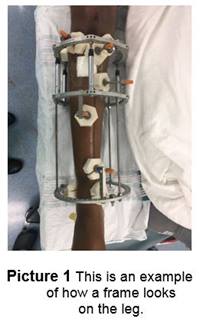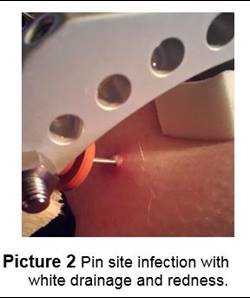Frame and Pin Site - Care at Home

External fixators (frames) are used to hold an arm or leg bone in place so it can heal after surgery for limb-lengthening or reconstruction. There are several pins or wires that are attached to the frame. They pass through the skin to the bone. The area where the pin or wire passes through the skin is called the pin site (Picture 1).

When your child comes out of the operating room with a frame in place, there may be sponges, gauze, or special tape around the pin sites. You do not need to change these when you go home. These dressings will stay on until your child’s first appointment after surgery. The frame and pin sites must be kept dry until your child’s first appointment, so baths and showers should be avoided. Sponge baths are OK and are encouraged.
Pin Site Care
At your child’s first visit after surgery, the dressings from surgery will be removed. After they are removed, your child will be cleared for bathing or showering at home. At this point, it is OK to get the frame and pin sites wet.
Good pin site care is very important in helping to prevent an infection. Always wash your hands before starting pin site care. Pin sites need to be washed every day with soap and water. This can be done during bathing or after. The soap and water should be applied directly to the pin sites.
Some good ways to do this include using one of these:
- Cotton swabs (Q- Tips)
- Gauze
- A clean washcloth
- A soft-bristle toothbrush
After applying the soap, rinse the sites with water. Apply dressing to the site as directed by your provider.
The frame may also have round silver discs on the pin and wire sites. These special dressings help to prevent a pin site infection. These discs should be kept on at all times. When washing the pin sites, pull the disc away from the skin. After cleaning the site, make sure the silver disc is pushed back against the skin completely. The silver discs should get completely wet at least once a day. If you notice the disc is dry, you should apply more water to it. These dressings will be changed during your clinic appointment. Sometimes you will be given an extra set to change in between appointments.
Do not use hydrogen peroxide or alcohol swabs around the pin sites, as this may irritate the skin. No ointments or creams should be applied to the sites. It is OK to apply lotion to dry skin as long as no lotion is placed on the pin sites.
At the first or second appointment after surgery, you will be given a prescription for an antibiotic in case a pin site infection occurs. You do not need to fill this prescription unless you suspect a pin site infection.
Pin Site Infections
Even with the best pin site care, an infection can happen whenever a frame is in place. The three most common signs of a pin site infection include:

- Pain. This is pain or tenderness around a pin site that often feels new and different from other pain or discomfort your child may have had with the frame. It is usually pain at a specific pin site and not pain that is all over. This is often the first sign of a pin site infection.
- Redness. If there is a pin site infection, there will often be redness that is spreading or getting worse around a pin site.
- White drainage. White pus draining from the pin site is a sign of infection. However, clear, yellow or bloody drainage is generally not a sign of infection, but instead is a body’s normal reaction to the pin.
Other common signs of a pin site infection include heat or warmth around a pin site, swelling, or fever.
How to Treat a Pin Site Infection
If you think your child has a pin site infection, you should start right away giving your child the antibiotic prescription that was given to you.You do not need to wait to speak with someone from the office. Give the antibiotic as directed and follow up with your child’s provider at the next scheduled appointment.
Along with starting the antibiotic, you should also:
- Clean the pin sites 2 to 3 times each day with soap and water instead of just 1 time each day. Do not clean with hydrogen peroxide. Do not place an antibiotic ointment on pin sites. Also, while treating the infection, get the silver discs wet 2 to 3 times each day.
- Add a sponge dressing to the pin site to help stabilize the skin and ease pain at a particular pin site.
Continue these steps until we are able to give you further instructions at your child’s next appointment.
If you have any questions or concerns, call the Orthopedic Surgery office at 614-722- 5175. Choose option 4 to speak with a nurse.
HH-II-233 11/17, Revised 09/19 | Copyright 2017, Nationwide Children’s Hospital


